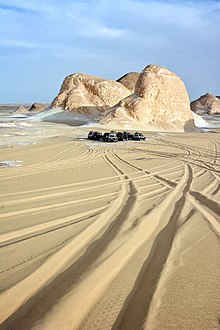White desert
The White Desert (Arabic: الصحراء البيضاء , el-sahara el-beida ) is located in the Egyptian part of the Libyan Desert around 30 kilometers northeast of the Farafra oasis and 130 kilometers southwest of the Bahariya oasis , and 420 km southwest of Cairo . Both oases were already around 8000 BC. Inhabited. In Pharaonic times they served as military “ outposts against marauding Libyan tribes” and as “places of exile and prison camps”.
The core area of the White Desert is about 12 km by 12 km and is known for its limestone formations, which make it a large natural sculpture park. The Western White Desert ( el-sahara el-beida gharbiya ), which impresses less with individual sculptures than with larger formations, must be distinguished from this.
White Desert National Park
In 2002 the White Desert and its surroundings were declared a national park. This extends over 3010 km² with a further buffer zone of 971 km². Park rangers have been patrolling since 2008 , and their tasks include collecting entry and accommodation fees from tourists. In 2007, 40,000 people visited the area. There is a leaflet as well as a map and information about the sights in the national park in English, Italian and Arabic.
The limestone monoliths are sedimented and calcified plankton from the end of the Cretaceous period 80 million years ago, when today's Mediterranean still covered the desert, which was later eroded by wind and weather and extreme temperature differences and their individual shape have received. Their shape is reminiscent of mushrooms, a chicken under a tree, a sphinx's head , human heads and the like. Many sculptures were destroyed by improper behavior by tourists, which was particularly noticeable until 2002 before the park rangers were deployed.
Original or fossilized shells, snails, ammonites, corals, animal bones and fossilized branches can be found in the White Desert. Three better-known springs, surrounded by palm trees and other vegetation, supply the local fauna (fennecs, gazelles, small rodents) and travelers with water. The sights include rock formations such as the double gate (el-Babein) or el-Aqqabat, an allegedly 2000 year old acacia (el-Santa), the crystal mountain and the cave of Djara. Locals show visitors natural mummies, supposedly from Roman times.
tourism
The White Desert is now a much-visited natural attraction, so that peace and solitude are not always given. Since the beginning of the millennium, the local organizers and the mostly Bedouin drivers have become more aware of the special ecological features and the need to protect the park area. For example, many travel companies offer rubbish removal campaigns, which you can register for in return for a share of the expenses.
literature
- Gottfried Aigner, Nana Claudia Nenzel: Egypt. Hamburg 1992, 1997 (= HB-Bildatlas Egypt Special ), ISBN 3-616-06416-3 .
- Wil Tondok: Egypt individually. 18th edition, Reise Know-How, Bielefeld 2011, ISBN 978-3-89662-476-5 .
- Alberto Siliotti: White Desert National Park. Geodia Edizioni and Dar el-Kutub 23648/2008.
Web links
Individual evidence
Coordinates: 27 ° 21 ′ 41 ″ N , 28 ° 7 ′ 26 ″ E




